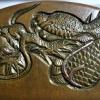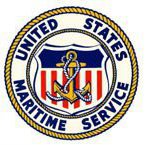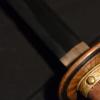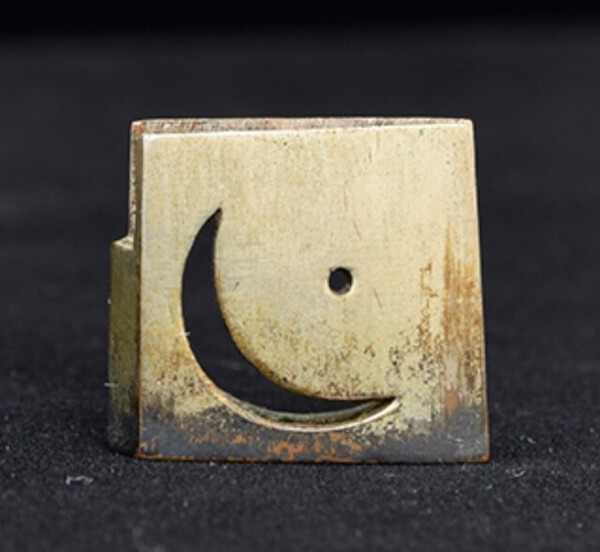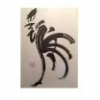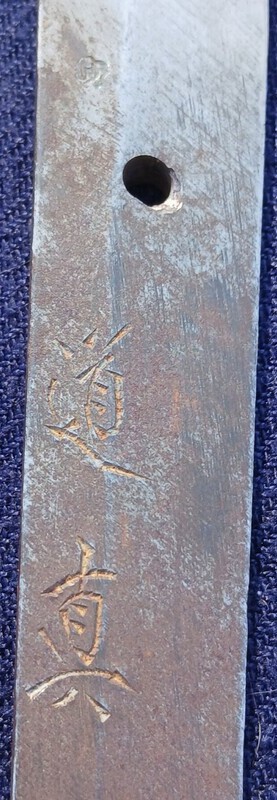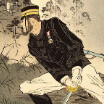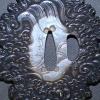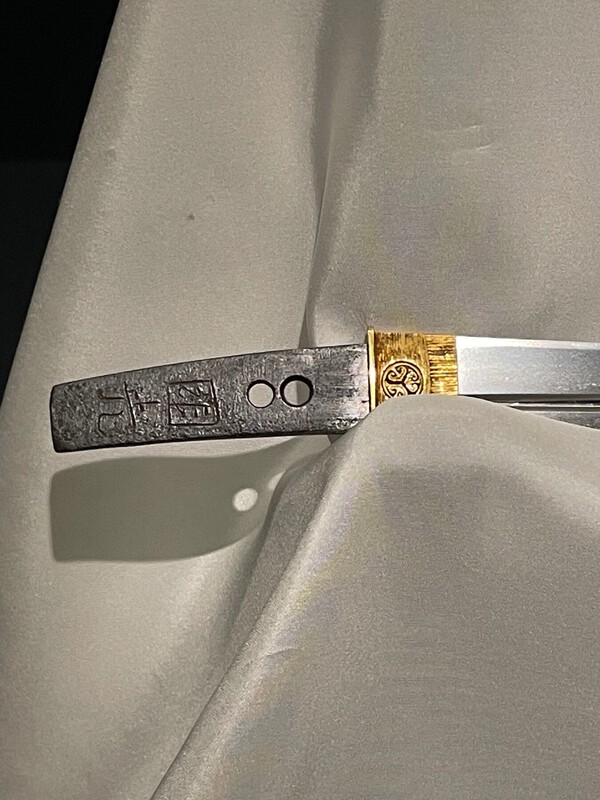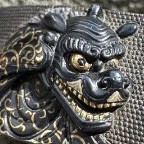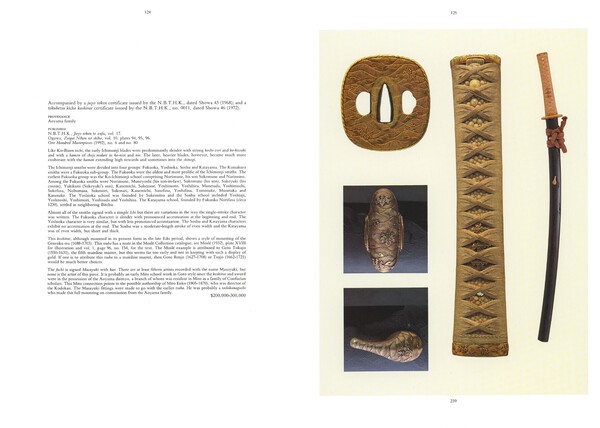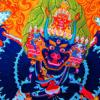Leaderboard
Popular Content
Showing content with the highest reputation on 06/30/2025 in all areas
-
3 points
-
Sadly no, Colin. It’s with Jan and he was still editing it last time I heard. It needs a kick-start. The world needs this book!!!3 points
-
I agree with Thomas, it looks a lot like a light weight Type 98. I own one that is similar. Just the proportions make me think it is a light weight.3 points
-
Last October I posted a thread about a Kamakura era tantō I found in Japan, signed Kunimitsu and dated 1308. The deal fell through at that time but in the interim months I kept thinking about it. Spurred on by the dealer stating he planned to have the Mei removed and blade polished before resubmitting to the NBTHK, I decided to redouble my efforts to acquire it. I just couldn’t let that fate befall it, especially as the NBTHK issued Horyu papers in 2018, so I found a way to complete the transaction and it's now in the possession of an intermediate. Fortunately the dealer hadn’t started the work. It was thanks to an investment in Markus’ Kotozen-HC that really spurred on my attention on this blade. I have no idea how this project will pan out but I think I’ve done enough groundwork to at least give it a chance. Here’s my story and a request for assistance. The Hunt Years ago while I was scouring the websites of Japanese retailers I came across a fairly obscure dealer. He has quite a large inventory but mostly lower to mid quality pieces often in poor state of preservation. Buried deep in tantō section was a blade that caught my attention. I made a mental note to revisit the listing later but forgot about it after a redundancy in 2021 and relocation to a different Continent. Then back in October last year I stumbled on the retailers webpage again and to my surprise the tantō was still listed. I should add this was also a consignment piece which the owner had inherited from his deceased father. The son was not a collector nor familiar with the swordsmith. In 2018 the dealer submitted the blade to the NBTHK but they couldn't come to a consensus and returned it with Horyu papers, and a request that further work was needed to authenticate the Mei. 2018/2019 Juyo Shinsa were a couple of those strange years at the NBTHK and I wonder if this contributed to the result for this blade. The dealer was unable to find the evidence that would advance its progress through Shinsa, so the blade remained in the shops inventory almost forgotten, and pushed further down the page. Horyu papers are quite unusual as the NBTHK gets no monetary return when these are issued. The good news though is that getting Horyu is not terminal, in that the Shinsa committee is not saying its gimei, just that there are differences to the usual Kunimitsu nijimei, to warrant additional research. Kunimitsu’s style of Mei is very unique and from what I can tell, consistent throughout his career. The Inconsistency The main 'problem' is the Kuni kanji. Instead of a vertical central line it's curved left to right although the reversal of the mirrored S and 3 parallel lines is consistent. How can this be explained? Fortunately this blade is dated 1308. At this stage the historical texts say Kunimitsu was at the end of his career and is believed to have died around 1312/13. His successor was his 2nd son Kunihiro. It was common practice for smiths of the period, at this stage of their careers, to focus on forging and give the honour of carving of horimono and signing the nakago (daimei) to the best apprentice, or in this case, the defacto successor, Kunihiro. As an aside Yukimitsu was likely the best candidate to take over the forge but he was not blood related and therefore ineligible. Markus states in his Swordsmiths list that all Kunimitsu's sons signed Kunimitsu after his death and that examples of daisaku exist. I have scoured the web looking for examples of Kunihiro's style when signing Kunimitsu and indeed have found several that slant in the normal way. There is no chronology for these signatures so his signing style around 1308 is unconfirmed. Kunihiro as well as Kunishige signed Kunimitsu in a couple of different ways, from 1317 on. Daimei-daisaku was not uncommon during this time and Darcy wrote an excellent essay comparing the 6 styles of signature for the early Rai school smiths. https://onihonto.com/archived-nihonto-ca-yuhindo-com-rai-kunitoshi/ There is a suggestion that the Midare-Kunimitsu, his only extant blade in the Soshu style, was in fact forged by Yukimitsu One of the main points I get from the article is that when an apprentice signed daimei the aim was not to precisely emulate the masters signature style, but to introduce slight variances to differentiate the author of the Mei. In this case Kunihiro added a normal slanted centre line in contrast to the master’s atypical vertical line, but maintained the unusual style of the mirrored S to the left and used a more standard style on the mitsu kanji, without the turn back stroke. The dealmaker If this was all I had to gone on I might have passed on the blade, but I fortuitously invested in Markus' kotozen publication and on pages 456-458 is what is best described as a dead ringer for my blade. The nagasa is almost identical, as is the motohaba, the style and positioning of the boshi is likewise similar. Shape of the nakago is the biggest difference but is consistent with other blades like the Aizu Kunimitsu. Another interesting feature is the characteristic Kunimitsu single sided Koshi-bi. Both blades have an almost identical Koshi-bi on the omote. I have measured the carvings using the munemachi as a reference point and they are almost identical in length. Fortunately the tantō in the book is also signed and dated by the Master himself, but 2 years earlier in 1306. Dated Kunimitsu blades are extremely rare and I only know of 4 including the one I found. It's conceivable that Kunihiro was designated heir-apparent within those 2 intervening years. A couple of blades are dated to the early 1320’s so likely Kunihiro signed Kunimitsu Mei as head of the workshop. One in particular has similar Shintogo jiba, is a shorter length so more characteristic of the father and shows yakikomi (perhaps a carryover blade from before Shintogo died?) What little of the hada that can be seen through the layers of oxidation look promising and that by itself makes it worth going through the various steps. It also has another kantei feature for Kunimitsu namely Yakikomi (absent in the 1306 blade and sometime only on one side) and is considered a sign of superior heat treatment executed by a Mastersmith, with the hardening extending into the nakago. This is something that Shintōgo Kunimitsu excelled at. It also has mitsumune another feature of early Soshuden and seemingly omnipresent on Shintōgo Kunimitsu tantō. Some style of Kuni kanji carved by Kunimitsu's apprentices/heirs A little more digging and I found a short video of the tantō from 1306, taken during an exhibition at the NBTHK last year: https://www.facebook.com/reel/416844547828291 Whats next and a request First thing I want to do is have Tanobe take a look at get his impressions, probably after a window has been opened. Then with a fresh, sympathetic polish I will have the blade resubmitted to the NBTHK. I have exhausted my references and online searches of styles of Kunimitsu Mei, but would be better to find more examples of daimei, daisaku Kunimitsu as mentioned by Markus. If anyone has examples shown in other references that would add support for a daimei attribution I would love to see them. All this information will be passed along for the Shinsa Committee to review to help them come to an informed conclusion. Is there any other supporting evidence I may have overlooked that would bolster the resubmission? Ultimately I think the quality of the jiba has to meet Shintogo Kunimitsu standard for it to be accepted. Did the 1306 blade appear after 2018? Any idea when it passed Shinsa and what papers it got? Goal I’m realistic that the tantō is not in the best shape having been subjected to many polishes over the years. But I will choose the most appropriate togishi to preserve what is left. My main goal is to have the blade attributed to Kunimitsu with daimei signature. If confirmed then this blade has important historical significance. It needs a tsuka, shirasaya and Tanobe sayagaki. There is also a page from an old book stuck to the saya which I would like to have translated. It mentions Masamune, Norishige and Kunimitsu but I’m unsure if there is a specific reference to this particular blade. The sun/moon habaki seems quite unusual too I'm looking forward to seeing where this leads and hope my gut feeling about this blade is justified. If anyone can provide any additional references I would be very grateful.2 points
-
I recently purchased an interesting Zoheito produced at Kokura Arsenal in May 1944. I’ve been researching it and studying it for the last week. It has some drastic drawbacks, but I also had some good, specific reasons to purchase it. I wrote this post to compile some information from several other posts and as a tool to help me get back into the study of this hobby. I. Zoheito Generally If you hadn’t heard of a Zoheito (like I hadn’t), a quick summary I liked was that a Zoheito is the commissioned officer equivalent to the Type 95 NCO Gunto: machine-made and arsenal-produced. However, references to them seem scarcer than I would’ve guessed: · Dawson page 68 shows a Type 19 Zoheisho-produced sword. However, the book doesn’t use the term “Zoheito”. · Plimpton doesn’t mention them at all that I could find. · The shorter Fuller and Gregory book doesn’t mention them either. · Ohmura, however, has a nice page on them: http://ohmura-study.net/206.html · And finally, there’s a great section in them on Malcolm Cox’s wonderful book on WWII swords from Fukuoka, Kokura Arsenal, and Kyushu: https://www.militaria.co.za/nmb/files/file/118-showa-period-swordsmiths-of-fukuoka-prefecture-kyushu-and-the-kokura-arsenal/ II. This Particular Sword This sword has been posted about several times on NMB: · https://www.militaria.co.za/nmb/topic/10853-mei-translation/ · https://www.militaria.co.za/nmb/topic/52349-sword-id-and-value/ · And actually, it’s even featured on page 116 of Cox’s WWII Fukuoka smiths book!! What’s interesting about this particular sword is the production quality. It seems like the vast majority of Zoheito are mumei, undated and only have a small acceptance mark and occasionally the Kokura stacked cannonballs. By contrast, this one has a very strong mei that reads: · Kokura Rikugun Zōheishō / 小倉 陸軍 造兵廠 = Kokura Army Arsenal, and · Showa ju kyu nen go gatsu / 昭和十九年五月 = Showa 19 (1944) May. The sword also has three stamps near the mune-machi: · KO - Kokura Army Arsenal Supervisory Section · HO - 1st Factory of Kokura Army Arsenal · 3 Furthermore, it has incredibly strong kiri yasurime along the length of the nakago. Back in 2016, these features led Mr. Chris Bowen to theorize to the previous owner (in this thread: https://www.militaria.co.za/nmb/topic/10853-mei-translation/ ) that the sword was actually Gendaito and made by Moritaka: http://www.jp-sword.com/files/blade/moritaka/moritaka.htm . I’m reaching out to Chris to ask if he has any follow-on thoughts or more details. It seems like there’s only been three similar swords reported to the NMB like this with a smith-style mei saying it’s Kokura Arsenal-made but no smith mei: · My sword · One made in February 1945 with the same style mei but with an RJT star stamp but no smith signature: https://www.militaria.co.za/nmb/topic/13623-kokuri-rigun-z%C5%8Dheis%C5%8D/#comment-142780 · Another December 1944 Kokura-produced Zoheito with the same style mei but without an RJT star stamp: https://www.militaria.co.za/nmb/topic/16353-interesting-late-44-gunto/ There are some other swords that have kanji indicating the sword was made at Kokura Arsenal but these are star stamped and signed by a smith: · Kasuga Seizōsho Fumitada, May 1945: https://www.militaria.co.za/nmb/topic/25118-gendaito-translation/ · Yoshinori made, May 1945: https://www.militaria.co.za/nmb/topic/4859-gunto-mei-help-please/ So my sword is interesting to me in that it seems like it has qualities of both Gendaito and Showato. After getting it in hand, I was hoping for a faint star stamp, but unfortunately none was present. As to the obvious flaws: the seller mentioned he inherited the sword from his father and he was unsure if it was his father who caused the damage to the sword with sandpaper or a prior owner. The father bought the sword in a 1970s flea market. But the damage is done, and the blade itself is very poor. However, the nakago and mei remain gorgeous and interesting in their own right. Why did I buy it? I’ve been majorly into Japanese firearms for the last four years and have amassed what I think is a nice collection of those (I’m the same username over on Gunboards if you’re interested). But Nihonto and Gunto are still very much things I enjoy, and I’m glad to have amassed a decent starter library to study and enjoy the swords I do own and think about future purchases. So when I saw a listing for the sword on a local firearms forum without photos, only about two hours drive from me, I was intrigued. I came to NMB to see if I could learn more based on the description and discovered it had been posted to the Trader section here for sale too, with photos. By the time I negotiated the price down, it was $300, and it came with some Type 95 fittings worth at least $100. Then my wife said she’d like to contribute $100 as an early Father’s Day present! Despite the poor polish, there were many qualities that sold it for me. First, I lived in Japan for a time and some of my happiest memories come from several months spent on Kyushu. As a result, in both swords and firearms, I very much enjoy Kokura-produced specimens. I intend to make my Nihonto collection into one focused on Kyushu-produced examples. My first Nihonto was a Bungoto: https://www.militaria.co.za/nmb/topic/36574-my-first-kantei-post-12-fujiwara-yukinaga-katana/ . The sugata and sori on this sword were pleasant to me, and I was intrigued by the mei and strong yasurime. So for being made at my favorite arsenal, the unique signature, a book-published sword, and for a net-$100 ($300 sword - $100 wife’s contribution - $100 Type 95 fittings), I couldn’t resist. III. Kantei Don’t laugh, please. I recognize this is a somewhat silly exercise to do on a beat up Showato, but I wanted to re-familiarize myself with the following terms and go through the exercise. I was only ever a novice to begin with, and it’s been four years since I’ve bought anything Nihonto-related. The knowledge here (on the specific meaning of the terms in particular) is definitely a perishable skill. I used the NMB Kantei sheet located here: http://www.militaria.co.za/articles/Kantei_Sheet.pdf . The measurements are in inches. Brief Overall Description: Zoheito made at Kokura Arsenal in May 1944. Shirasaya length: N/A. Overall length: 34 3/8. Nagasa lengh: 25 6/8. Nakago length: 8 5/8. Kasane: 1/4. Mekugiana: 1. Mihaba: 1 1/2. Motohaba:1 1/4. Sakihaba: 13/16. Motokasane: 1/4. Weight: 2 lbs 0 oz. Sugata shape: Shobu-zukuri – See my questions below. There is no yokote visible, and I wonder if that’s intentional or due to the rough handling this sword has had. Hada: Very difficult to determine with the scratches. Perhaps muhi-hada or maybe masame-hada. Sori: 7/16; Type: Torii-zori. Kissaki: Chu-kissaki. Mune: Iori-mune. Hamon: None visible. Yakiba: None visible. Boshi: None visible. Nakago: Ubu; Nakagojiri: Kengyo but close to Iriyama-gata. Yasurime: Kiri (and incredibly strong too). Bohi: None. (I’m still trying to get “No-Hi” as a term to catch on ) Koshirae: None. Polish: Very poor. The blade has been the victim of some sanding along the edges and has scratches throughout. Period: Gendaito. School: N/A. Origami: None. IV. Questions. 1. Showato or a Gendaito? - My gut says Showato due to the lack of an RJT star-stamp. However, since other examples exist that lack a smith’s signature but do have a star-stamp, maybe this one just missed getting its star. I’d love that to be the case, but I worry that’s just wishful thinking. I’d love your take on it. The polish is bad enough that it’s probably impossible to tell in its current state. I can’t even really make out the jihada. What do you think? 2. No yokote? - Interesting to me to see that there’s no visible yokote. Does the shape of the sword look like that’s intentional? That’s my take. Or could it have been sanded/ground off? 3. Buying koshirae and habaki? – I’m wondering if trying to find a koshirae (or at least a tsuba and tsuka) is a fool’s errand. What’s your best recommendation for trying to match up fittings? I don’t want to sink too much more money into it, but it would be nice to at least have a proper tsuka on here for handling/display. If you stuck around this long, thanks for reading! If nothing else, this sword was a great way to get me hooked back into the hobby at a cheap price and start reading and engaging here again. I’d love any thoughts you have about the sword, process, or write-up. PS - More photos to follow shortly as I jigger with the size limits.2 points
-
Here is a signature from the DTI catalogue a few years back. Tokuju Shintogo, although most likely a daimei work with the Kuni and Mitsu characters being those of students, probably Kunihiro. Of note, there are only a small handful of Shintogo Tanto in the NBHTK’s records where daimei can be ruled out, if you take the latest opinion on the master’s authentic signature. Approving a new Shintogo is a big decision. The NBHTK will not validate it unless the workmanship is up to par, and this means it must be in a decent level of polish beforehand. As you can see with the image I posted, the mei is rather close. Note the radical stroke direction on the Mitsu, and the shape of the various elements on the Kuni. Keep in mind that the inclined mid-line on your Kuni is the biggest question mark element, although there is some very rare precedent for it but only in the old Kozan Oshigata (and the mei therein are approximations...) as you can see in the attachment. If the quality and features are aligned with Kunihiro, and with this type of mei material as supporting evidence, you have decent-good odds of it being accepted. However, if the quality and the features of work, once revealed by the polish, are not up to par or leave areas for doubt, it is unlikely that they will expand the canon on acceptable signature variation. As next step, I recommend to take a pen and replicate the mei while marking the stroke direction on every character, then compare with a corpus of Shintogo mei that you assemble in the course of your research. Good luck on your quest.2 points
-
Hell, my name's Kyle, and I'm eager to learn more about Yari/Nihonto. I've already learned quite a bit from the archived posts, looking forward to learning even more. Thanks all in advance.2 points
-
its a nice work, but i think the price might be eye watering2 points
-
Thanks! I assume these were also "check-weld only" stocked rather than shot from the shoulder? I ask this because for example we see both in this excellent video from Prof. Németh The 265 early 16th century tinder lock firearms of Pilsen2 points
-
@Bruce Pennington @Joseph P. there looks to be an error in the Sesko list with two smiths (from original Seki list): Made in November 1944. I think you have the name right. Sesko lists 2 by that name working during the war: "MICHIZANE (道真), Shōwa (昭和, 1926-1989), Gifu – “Michizane” (道真), real name Kosaka Takao (小坂隆男), born February 20th 1921, he worked as guntō smith and died December 17th 1964 MICHIZANE (道真), Shōwa (昭和, 1926-1989), Gifu – “Michizane” (道真), family name Nagao (長尾), he worked as guntō smith, ryōkō no retsu (Akihide) There is only one MICHIZANE and his real name was NAGAO TAKAO 道真 長尾 隆男 born Taisho 10 (1921) February 20, registered as a Seki smith on Showa 16 (1941) August 7. He was a student of Asano Kanezane. In 1942 Banzuke (Akihide) listed as Nagao Michizane. Looks to be also read as MICHISANE, but more likely "zane" is correct as a student of "Kanezane". These NOSHU examples with Sho stamp look to be katana-mei and well made Showato. Your blade is later war Nov 1944 and as noted through Nagoya Arsenal with small Seki stamp and Gifu stamp. Also is signed tachi-mei and in rinji seishiki koshirae. "Zane" is cut slightly different.2 points
-
2 points
-
It's a good question. @Kiipu would be the one who might have a good detailed answer; as my focus has been mostly on cataloging and dating. (But I am getting there! ) It's my understanding that Kokura administered the 95 program, but did not directly make or even supervise the making of the swords. Therefore your sword was presumably made and stamped at the Tokyo First Arsenal rather than traveling to Kokura to be stamped. Cool sword, and thank you for sharing! -Sam2 points
-
It would be: Showa - 昭和 10 - 十 9 - 九 Year - 年 10 - 十 1 - 一 Month - 月 All together, Showa 19th year, 11th month (November 1944) Showa was an era of Japanese history corresponding to Emperor Hirohito (Showa) from 1926 (Showa 1) to 1989 (Showa 64) when he died.2 points
-
Reminds me of the light weight Type 98. There were Murata imitations as Murata himself mentioned it in an interview. This interview can be found over Ohmura's website.2 points
-
@Scogg That’s wild! I’m always interested to learn about the variances between different manufacturers. You see that with firearms during the war too. Really intriguing. I probably will pick up a copper fuchi’d one at some point, as I enjoy getting Kokura-marked things.1 point
-
Dear Lewis B, This is Setsuko Chano ( 茶野 節子) I found your post yesterday fortunately. Regardeing a photo of Saya ( 鞘〉I found Dr. Roretz Jananese name老烈先生. I think that it seems to be able to idntify Number 2472 (75) in the list, "Aoje Sujeh, Provinz Boshin 2? lang gekurzt. Scheide weiss. Geschenk des Hara Kikohiro". Would you agree with my thoughts on this ? As you are German, you could read a short explanation about Japanese swords written by Dr. v. Roretz in the list. Dr. Roretz collected most of swords in Nagoya in 1876-1880. He learnt the evaluation method from Ozaki Tadakage 尾崎忠景( belonged to Owari Clan ) accoding a book written by Prof. Shoji Katoh of Nagoya University. I contacted Professor Katoh to get the souce of Ozaki Tadakage as a sword sevaluator. Because Ozaki Tadakage's name is not found as Swords evaluators name lists at present. As a Owari Cran, I found some records on him in our history. I would be grateful if you would let me know contacts of the person in charge when you have visited to Styer MesserMuseum in 2024. I shall go to the museum this August together with my husband and descendants of Dr.von. Roretz. They know the direktor of the Museum. Looking forward to hearing from you soon. Kind regards, Setsuko Chano1 point
-
1 point
-
Hi, Nakago looks legit. However, maybe it is due to the pictures, Sugata and Kissaki seems odd. Especially for early EDO (I agree with @ROKUJURO , based on patina color of Nakago). Like I said, it might be the pictures, but also could be a school that I'm not familiarized with. What are the measurements?1 point
-
Bruce is correct, it's definitely an old myth. Iijima in particular seems to have produced "pattern 2" swords until near the end of the war, while other arsenals transitioned to "pattern 3" earlier. It's easy to assume "pattern 2 is earlier than pattern 3", but it really depends on the specific arsenal and company. All the best, -Sam1 point
-
It is an old myth that the steel fuchi and tsuba were late war. Richard Fuller has a brief chart showing them seemingly randomly scattered throughout the serial numbers. On that, though, @Kiipu might have a more specific answer.1 point
-
Trying to sleep as I must be up at 4:00. Can’t believe how many people have chosen today of all days to get in contact! The two on the left are in the museum in Tanegashima. The top one may be an original barrel, but it was in a fire and rebuilt in Meiji. The bottom one looks to be a sort of copy maybe from mid-Edo.1 point
-
1 point
-
It’s as you say, Fabien, and some of us have spent years tracking down the answer to this. The quick answer must be yes, they were Portuguese snapping matchlocks with the sprung-and-released serpentine falling forwards, away from the shooter. All subsequent Japanese matchlocks, large and small, follow this remit, with a myriad of detail, geographical and gun school variations. Sawada Taira in Nihon no Furujū calls this age, from 1542-1600, (roughly the first 50 years), the Dark Age, because so little has survived, and even less is dated. There are a few photos of guns or parts of guns in his book that have been passed down with attached stories. The museum in Tanegashima has two guns in their large collection which they confidently call ‘original’ but this story must be taken with a pinch of salt. Ian Bottomley says there is at least one quite original gun in the Tokugawa Art Museum in Nagoya, which they do not show people. Something I discovered, or realized, as they were staring everyone in the face, is that early dated Goto Kinko work showing designs of guns and accessories, must actually be among the very first illustrations of imported (or careful copies of) Western guns, before the luxury of subsequent Japanese modifications. Find examples of forward snapping Portuguese matchlocks from Goa (and Africa) and you’ll be seeing roughly what reached Japan, before the Japanese sensibility started refining the concept. The oldest Japanese matchlock guns I have handled tend to be rather spartan, functional but heavy in relation to the bore. (This is all covered in the book Jan and I have written. Hoping it can more forward…)1 point
-
Quite common. Popular themes were made over and over, with designs copied between schools and down the ages. Workshops also often made fittings in batches, so you can come across 'identical' examples. Same with tsuba.1 point
-
Big fan of Yukimitsu and his work, and this blade in particular. Give me a few years to save up to buy it please1 point
-
You will probably have better luck finding a set of Type 3 fittings that will fit this Sugata. It will be somewhat of a wild goose chase with high potential of spending more on the fittings than you have on the blade.1 point
-
Hi, I've seen a couple of claimed wwii gunto's up for auction in the last couple of months in the UK, but to my untrained eye, the Kabuto-gane ( hope this is the correct term!) and the odd flattened top loops seemed off - I've attached two different examples. I only saw off as I couldn't see anything like this on any site showing lots of examples of wwii swords. Quite enjoy reading about the more common fakes so would be interested to know if this is a common sign, or alternatively if it could be legitimate. I didn't buy either so no urgency, purely curious!1 point
-
新藤五国光 (Shintōgo Kunimitsu) was, in effect, the founder of the Sōshū tradition; three celebrated smiths—Yukimitsu, Masamune, and Norishige—trained under him. At first glance his workmanship recalls the Yamashiro Awataguchi school, yet the prominent chikei (dark steel lines) and kinsuji (bright “golden” lines) that appear in the steel surface are hallmarks of his blades. Kunimitsu favored straight hamon (suguha) of varying widths and, as a master of tantō, is considered a peer of Fujishirō Yoshimitsu. This tantō is forged from well-refined steel showing delicate chikei and is tempered in a neat, narrow suguhahamon. With a slight inward curve (uchizori), the harmonious balance of its steel texture and hamon gives the piece an appearance of dignity and refinement.1 point
-
1 point
-
None of these swords could be licensed. The licensing system is only for Japanese swords. There was some debate in the early years of the licensing system about whether or not foreign swords should be allowed to be licensed and held in private collections. If I'm not mistaken there was one collector who sued the government because he could not get his antique foreign sword licensed, with the government eventually winning the case. So the defacto position is that only Japanese swords may be licensed.1 point
-
I have used my EORI number (from my VAT-registered company) to register with the EU. I will hear back about this registration next week. Greetings, Lex1 point
-
Thank you! That’s surprisingly early. Given the fittings, I would’ve taken a guess at 43 or 44. Do you know what hat the Kokura supervision entailed? Did the weapons travel down to Kokura for inspection after completion, or were there Kokura employees on site at Tokyo and Nagoya etc to finalize them after completion (my assumption)?1 point
-
Thanks. Considering the first time I even held a Japanese sword was only a year ago I feel blessed and whatever the outcome, I'll have enjoyed the journey.1 point
-
That's interesting. I guess you figured out why my negotiations failed then. I don't think the consigner wanted to sell to a non Japanese unless it was for a ridiculous price, given the current state and status. I had to employ a local to negotiate on my behalf. Taken in the round the price was good enough to have a punt. I doubt I'll come across another affordable Kunimitsu tanto so decided to roll the dice and take a chance. The old romantic in me sees this sword in 1308 possibly being in the same vicinity as some of the greatest sword makers of all time, namely Norishige, Yukimitsu and Masamune. They may even have handled it The next couple of years will be fascinating. And who doesn't love a project.1 point
-
I’m not trying to be smart, this is a genuine question……does it being in Japan with a Torokushi prove its not a fake?1 point
-
1 point
-
1 point
-
But Brian, Dan never even mentioned CAST TSUBA! From Colin's original post 'A modern reproduction of a late 19thC Japanese cast metal tsuba'. How I read this is the tsuba was based on a cast tsuba - not that this is a cast tsuba. That is, if the auctioneer knows where to place commas or has a grasp of punctuation marks [none of which are evident]! Something the millennials have come up with:1 point
-
No, I have not seen this stamp before. It looks like an encircled katakana MO. ㋲ = encircled katakana モ.1 point
-
1 point
-
Hi Everyone My name is Sebuh, i’ve recently gained an interest in Nihonto at the young age of 17. (Just turnt 18) After years or watching al sorts of media, seeing the Katana used and all. Guess that what’s caused my interest or, at-least planted the seed in my mind. After a few months of hiding around and obsessively reading content on Kamakura swords, my tastes have evolved. I appreciate Heian now, far far more. Late Heian to Early Kamakura seems to be my area. I’m based in New York City, Queens to be precise. Currently the only person not above the age of 40 into the hobby I think. I’ve been looking into the New York Token Kai, but a bit worried that i’d be the youngest there but i’ll make way eventually. Apologies for not introducing myself sooner, but it’s never too late. (hopefully)1 point
-
1 point
-
In my opinion, it is a forged blade and not a factory made blade. However, evaluation is usually done in hand or by pictures of a blade in some sort of polish. The "Star" stamp did not show up at the Kokura forge until 1945. The blades made before then, such as 1944, did not have one. May to December 1944: No star stamp. February to May 1945: Star stamp.1 point
-
The sword in the OP was made in an arsenal forge and not a factory. It is traditionally made as that was the purpose of the arsenal forges. Besides Kokura, Tōkyō 1st and Ōsaka 大阪陸軍造兵廠研究所軍刀鍛錬所 had arsenal forges. A zōhei-tō 造兵刀 [Arsenal Sword] is a wartime machine made blade just like a Type 95 blade.1 point
-
1 point
-
1 point
-
Very aggressive koshi-zori curvature may be not too consistent with Masamune style. Out of polish Muromachi blade is suspected. Overall almost nothing of sword value has been exported from Japan before Compton's time. Even MFA collection held in very high regard when you handle the blades, they are big names but aside from one or two pieces are lesser works. It is not at the level of high end modern private collections. Until almost now having foreigners to take good old blades out of Japan was considered unthinkable. In 1900 aside from junk and soft metal tosogu, even high class, it was just not happening. Plus collectors back then knew nothing. Even today its still very much a sensitive issue.1 point
-
1 point
-
0 points
-
0 points
This leaderboard is set to Johannesburg/GMT+02:00

